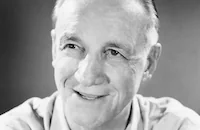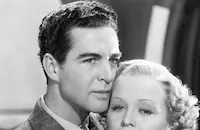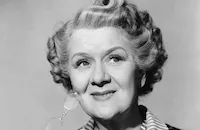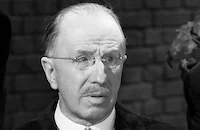Song and Dance Man
Cast & Crew
Allan Dwan
Claire Trevor
Paul Kelly
Michael Whalen
Ruth Donnelly
James Burke
Film Details
Technical Specs

Synopsis
Julie Carroll returns home after a show while her song and dance partner, Hap Farrell, goes to a bar and gambles away their week's pay. To make matters worse, Hap sprains his ankle while showing off, thereby preventing them from working. Distraught at having no money to pay their back rent, Julie decides to pawn Hap's gun. The pawnshops are closed, however, and when she tries to sell it to rich playboy Alan Davis on the street, he assumes that she is trying to rob him and knocks her out. He then puts her in a cab with him, and when she tells him her story, he takes her to see his friend, Broadway producer C. B. Nelson, with the hope that Nelson can give her a job. Nelson is not convinced by her story though, and calls the police. Lieutenant Mike Boyle then goes to the boardinghouse to question the landlady, Patsy O'Madigan, and Hap, who presents his permit for the gun. Hap and Patsy rush to the jail, where they meet Alan, who is also there to rescue Julie. Hap warns Alan to stay away from Julie, and they leave after she is released. The next day, Alan convinces Nelson to give Julie an audition, but Hap comes with her, as they assumed that the audition is for their act. It is not until after Crosby, Nelson's director, sets Hap straight that Julie sings alone and impresses Nelson. Julie soon finds out that Alan is backing Nelson's show and wants her to sign a contract with them, but when she goes to Alan's house, she refuses to sign because Nelson wishes to hire only her. Hap arrives angry at Alan for trying to steal Julie, but when Alan tells him that he will drag Julie down, Hap agrees to convince Julie to go it alone. At dinner that night, Hap puts on a drunk act and tells Julie she is holding him back. Julie is crushed, even more so when Hap subsequently disappears from the boardinghouse, and so she agrees to do Nelson's show. At rehearsals, however, Crosby gives her a rough time, hoping to make her quit so that he can give her part to his girl friend. Three weeks go by, and one night Alan proposes to Julie, but she tells him she is not ready. He confesses that he convinced Hap to drop out of her life, and after Julie relays the news to Patsy, Patsy finds Hap working as a Santa Claus in a toy store. Patsy tells Hap that Crosby is not giving Julie an even break, and Hap goes to the theater. Julie is in tears after eighteen straight hours of rehearsal, but Hap cheers her up, punches out Crosby and takes command of the show. Alan makes Nelson give Hap a chance, and Hap whips the show into shape, producing a winner on opening night. After the performance is over, Julie tries to prevent Hap from leaving, but Hap, realizing that Alan can offer her success and a better life, gallantly says he is going to the West coast.

Director

Allan Dwan
Cast

Claire Trevor

Paul Kelly

Michael Whalen

Ruth Donnelly

James Burke
Helen Troy
Lester Matthews

Ralf Harolde
Gloria Roy

Margaret Dumont

Billy Bevan
Irene Franklin
Lynn Bari
Dorothy Dearing
Julie Cabanne
Ruth Peterson
Anita Thompson
Mary Blackwood
Marie Stevens
Juana Sutton
Virginia Myers
Aurelia Fairfax
Fred Wallace
Harvey Perry
Tammany Young
Jerry Miley
Bob Callahan
Bert Morehouse
Joe North
Clayton W. Kirby
Ione Reed

Arthur Hoyt
Tom Ricketts
Margaret Mann
Rhea Mitchell
Ara Haswell
Dave Kashner
Bull Montana
Dorothy Bay
Robert E. Homans
Pat Hartigan

James Flavin
Ernie Alexander
Richard Powell
Wilson Benge
Cyril Ring
Crew
Stephen Morehouse Avery
Edwin Burke
Sidney Clare
Duncan Cramer
Lewis Creber
Al De Gaetano
Fanchon
Maude Fulton
James Gleason
Samuel Kaylin
William Lambert
Gladys Lehman
George Leverett
Barney Mcgill
Lew Pollack
Aaron Rosenberg
James Ryan
Dore Schary
Sol M. Wurtzel

Film Details
Technical Specs

Quotes
Trivia
Notes
The opening credits introduce this film as "George M. Cohan's Song and Dance Man." According to Hollywood Reporter news items, in June 1935, before Fox merged with Twentieth Century, the film was scheduled to be produced at Fox's Westwood Studio as an "A" picture starring Alice Faye and James Dunn, with Edwin Burke the possible director, and Burke and Gladys Lehman the scriptwriters. At that time, the picture was to be called Song and Dance. Hollywood Reporter later noted that the film's title would be changed to The Song and Dance Girl and would star Claire Trevor, with a script by Stephen Morehouse Avery and Dore Schary. Dunn, dissatisfied with his recent assignments from the studio, was subsequently released at his own request from the film and his contract with Twentieth Century-Fox when the film was postponed. Rochelle Hudson was also briefly considered for the role of "Julie Carroll." The film subsequently was produced at Fox's Western Avenue studio as a "B" picture under Sol Wurtzel. According to Hollywood Reporter, Homer Griffith, a former star USC quarterback and local pro football player, was to be a singer in the film, but his participation in the finished film has not been confirmed. This picture marked the screen acting debut of popular radio comedienne Helen Troy. An earlier film also based on George M. Cohan's play was made by Famous Players-Lasky in 1926, and was directed by Herbert Brenon and starred Tom Moore and Bessie Love (see AFI Catalog of Feature Films, 1921-30; F2.5245).












